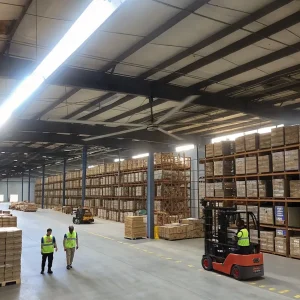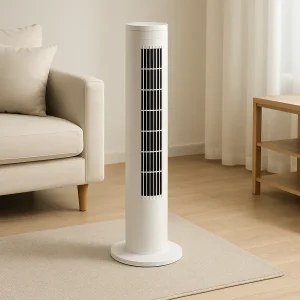Choosing the right fan for your space can feel overwhelming. With so many types—each claiming to offer efficiency—it’s easy to make a costly mistake. But when airflow, energy savings, and cost efficiency matter most, understanding fan types is your best solution.
The most efficient fan type depends on your space and purpose. For large areas, HVLS and centrifugal fans are the most energy-efficient. For homes or offices, ceiling fans, tower fans, and smart pedestal fans offer effective cooling with low energy use.

Industrial HVLS fans installed in warehouse ceiling
Fan efficiency isn’t just about speed or how strong the breeze feels—it’s about how much 风扇可以移动空气 with the least amount of 能源消耗. Efficiency varies based on:
Fans that 移动空气 effectively while drawing minimal power reduce operating costs, improve comfort, and lower environmental impact. High-efficiency fans also produce less noise and last longer with proper care.
Key efficiency measures:
| 特征 | Efficient Fans Offer |
|---|---|
| Airflow Volume | High CFM rating for space coverage |
| Energy Use | Low wattage or energy star rated |
| 耐用性 | Industrial-grade motor, bearings, and housing |
| Smart Control | Variable speed, motion sensor, or remote |
To make a smart decision, it’s essential to compare different 粉丝类型 and their efficiency across real-world applications.
离心风机 are commonly used in industrial settings where high pressure airflow is necessary. These fans pull air into the fan wheel and push it out at a 90-degree angle, creating high static pressure—ideal for ductwork, 通风系统, 和 高温 环境。
Why centrifugal fans work best:
However, centrifugal fans are usually larger, noisier, and more expensive than 塔扇 或者 落地扇. They are efficient in specific environments, not for household cooling.
Explore how centrifugal fans work in large commercial setups
轴流风机, on the other hand, are widely used across applications—from cooling fan units in electronics to large-scale 工业冷却. They operate by moving air parallel to the fan blade axis and are best for situations needing high airflow at low pressure.
Axial fans tend to consume less energy when not battling pressure loads, making them more energy efficient in open spaces.
Tower fans are a popular choice in homes and offices due to their compact size, modern design, and oscillating airflow. Although they don’t produce high CFM like industrial fans, they 空气流通 well in small to medium rooms.
However, the 风扇转速 and airflow power are limited compared to 轴流风机 或者 离心风扇. If you’re choosing a fan to cover large areas like 仓库 或者 健身房, tower fans are not the best option.

Slim tower fan for home use
落地扇 和 台扇 are flexible and portable, making them perfect for temporary or personal cooling. These electric fans can be easily moved between rooms, adjusted for 风扇转速, and tilted to direct airflow.
While they offer decent energy savings and airflow direction control, pedestal and table fans are not designed to 移动大量空气. They are not suitable for environments requiring strong, continuous 通风 or cooling.
是的-吊扇 remain one of the best ways to 空气流通 efficiently, especially in 工业的 或者 商业的 spaces with high ceilings. Their energy draw is minimal compared to 空调 units, and they help keep 暖空气 down in the winter and 凉爽的空气 moving in summer.
Modern ceiling fans, especially HVLS 风扇 (high-volume, low-speed), offer massive 节省能源。 这些 粉丝工作 有效地 工厂, 健身房, 和 体育中心, delivering comfort with low operating costs.
Discover how ceiling fans help cool large facilities
Bladeless fans are quieter and safer, with a futuristic design that draws air into the base and pushes it through a ring to 凉爽的空气 effectively. They’re best for homes or offices prioritizing safety and aesthetics.
Smart fans, whether tower or 座, integrate with apps and voice assistants, allowing users to set timers, schedules, and speed automatically. They offer convenience and 能源效率 when cooling is needed in short bursts.
However, these fans are often costly and are more suited to personal use rather than 工业风扇 needs. For large facilities, 离心 或者 HVLS 风扇 remain the best options.
当谈到 工业冷却, only certain 风扇类型 meet the demand for 空气量, low noise, 和 long-term durability.
每个 风扇类型 has specific applications. For example, 离心风扇 处理 高温, 连续工作 operations. HVLS 风扇 非常适合 cooling your home or business efficiently without high energy bills.

大型仓库中的 hvls 风扇
When selecting a fan to move air across wide or tall areas, it’s important to consider 风扇设计, 风扇叶片 size, and application. Here’s how some different types of fans compare:
| 风扇类型 | 最适合 | 效率 | 覆盖范围 |
|---|---|---|---|
| Tower fan | Bedrooms, offices | 缓和 | Small |
| 落地扇 | Personal cooling | Good | 中等的 |
| Ceiling fan / HVLS fan | Warehouses, gyms | 出色的 | Very large |
| 离心风机 | Industrial exhaust | 高的 | 高压 |
| 轴流风扇 | General 通风 | 高的 | Wide area |
| Smart fan | Homes, offices | Good | Small to medium |
| Bladeless fan | Safety and style | 缓和 | Small |
Axial fans move air in a straight path, making them great for continuous 空调 or supply needs. 离心风机 pull air into the center and push it out at a 90-degree angle, useful in high-pressure, ducted 系 统。
HVLS(高风量、低速)风扇 代表着 工业风扇 engineering. These large 吊扇 span up to 24 feet and 移动空气 gently but thoroughly across vast spaces.
These fans are not just about airflow—they impact your facility’s overall 能源消耗, 舒适, 和 operating costs. Compared to traditional 空调 units, HVLS fans provide better ROI, especially when paired with smart controls.
Explore more: HVLS fans for commercial applications
一个 energy-efficient fan balances 空气流动 with minimal power usage. This depends on:
To achieve 节省能源, many businesses switch from electric fans 和 air conditioners to HVLS or 离心风扇 for long-term savings.
选择 右风扇 depends on your specific space and needs. Ask:
If you manage a facility such as a 仓库, 健身房, 或者 工厂, the right answer is almost always an 工业风扇 like HVLS or 离心 types.
How to select the best HVLS fan for your factory
Which type of fan is most energy-efficient?
The most energy-efficient fan is the HVLS (High Volume Low Speed) fan for large commercial or industrial spaces. For residential settings, 吊扇 和 能源之星 certification and brushless DC motors offer excellent efficiency.
What is the difference between axial and centrifugal fans?
轴流风机 move air in a straight line and are best for moving large volumes at low pressure. 离心风机, on the other hand, are designed to generate higher pressure and are ideal for ducted 或者 排气扇 系 统。
Do fans really help with air conditioning efficiency?
Yes. Fans, especially 吊扇, help 空气流通 and reduce hot or cold spots. This lets you raise the 恒温器 in summer or lower it in winter, reducing 能源消耗 without sacrificing comfort.
Are bladeless fans worth it?
Bladeless fans offer safety, quiet operation, and modern design. However, they typically 减少空气流动 than traditional 风扇叶片 models and may not be ideal for 工业冷却.
Which fan works best for gyms or sports centers?
大的 HVLS 风扇 are the best option. They cover wide areas, 空气流通 efficiently, and provide 降温 without noisy operation, making them ideal for athletic facilities.
How often should I maintain industrial fans?
It’s recommended to follow a strict 保养计划: check for 振动, lubricate bearings, inspect 发动机 health, and clean the 风扇叶片 every 3–6 months for optimal performance.
To wrap up, here’s what you need to remember when choosing the most 高效风扇 for your space:
Whether you’re managing a 工厂, outfitting a commercial gym, 或者 installing ventilation in a 仓库, selecting the right 风扇类型 ensures better comfort and 能源效率.